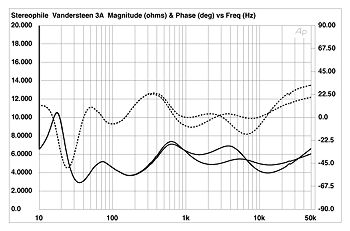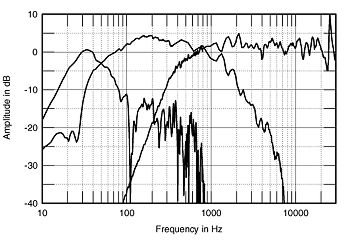| Columns Retired Columns & Blogs |
Vandersteen Audio 3A loudspeaker Sidebar 3: Measurements
Sidebar 3: Measurements
JA measured the Vandersteen 3A and provided me with the results after I completed my listening tests and wrote up the results.
Footnote 1: Other than impedance, all acoustic measurements were made with the DRA Labs MLSSA system and a calibrated B&K 4006 microphone.—John Atkinson
JA measured the Vandersteen 3A and provided me with the results after I completed my listening tests and wrote up the results.
The Vandersteen's sensitivity measured lower than specification at an estimated 85dB/W/m (B-weighted). Its impedance is shown in fig.1. The magnitude remains below 6 ohms for much of the range, and dips to a minimum of 2.8 ohms at 35Hz—this, I assume, the tuning of the active acoustic (bass) coupler. This is a moderately demanding load, though the phase angle is low, except in the low bass. The moderate changes due to the various settings of the midrange- and tweeter-level controls can also be seen in fig.1. Also visible are small ripples in the magnitude plot between 300Hz and 400Hz—possibly due to cabinet resonances—and a ripple just above 25kHz indicating the tweeter resonance.

Fig.1 Vandersteen 3A, electrical impedance (solid) and phase (dashed) with tone controls set to maximum (top at 10kHz) and minimum settings (2 ohms/vertical div.).
Fig.2 shows (from left to right) the nearfield responses of the active Acoustic Coupler, the woofer, and the midrange unit, the latter two spliced to quasi-anechoic measurements taken at a 50" microphone distance (footnote 1). (The axis was 39" above the bottom of the cabinet.) The output of the Acoustic Coupler peaks at 32Hz. It has some rough-looking resonances in the upper part of its range, but they're 15-20dB down in level, and, of course, directed to the rear of the loudspeaker. The main woofer has a generally smooth pass-band response, though it has a number of small peaks in its upper-range response as it rolls off above its upper crossover frequency.

Fig.2 Vandersteen 3A, acoustic crossover on optimal axis at 50", 39" from the floor, corrected for microphone response, with nearfield woofer and bass-coupler responses plotted below 300Hz and 850Hz, respectively.
Footnote 1: Other than impedance, all acoustic measurements were made with the DRA Labs MLSSA system and a calibrated B&K 4006 microphone.—John Atkinson
- Log in or register to post comments




































